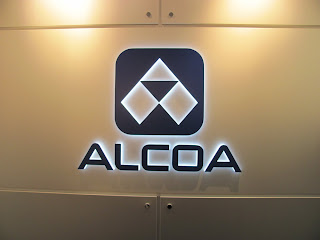Alcoa International Ltd. Visit
Our Cohort visited with Anil Govada, Managing Director of Alcoa Asia Pacific today. It was a very informative visit as Anil talked about working and living in Hong Kong and about what it takes to be successful in doing business in Asia.
Anil started out talking about the history of Alcoa and Aluminum. Coming from an Engineering background, I found this very interesting and it reminded me just how much I have forgotten since obtaining my bachelors degree. In particular when he mentioned Young's Modulus, I recalled it from material science but did not remember exactly what it was. Now that I am able to perform a search I see that I may have recalled more than I had thought at the time. It's just that I have not had a chance to use it so it was on the shelf.
Warning, the rest may be a bit dry so move to the next paragraph unless you want to read about Young's Modulus. I was recalling that there are four different ways to test the strength of a material although I could only recall the names of two. When I did a search on the web I found that yes there are four measures of stress of a solid material. They are compression, tensile, shear, and torsion. Young's Modulus is the measure of the stiffness of a material and can be determined from the stress-strain curve of a material. I recall being in a lab at Broome Community College when we were shown a machine for testing the tensile strength of materials. A material will be able to maintain its dimensions when being pulled apart to a certain point then the material will start to deform and then finally snap in two. Young's Modulus can be determined from this test if you plot the length of the bar compared to the load applied to it. Young's Modulus will be the slope of the straight line while the material is able to handle the load. Once the material starts to give the plot will turn to a curve until the material breaks. OK, back to Business.
I had not thought much about how long aluminum has been around therefore I did not think of it as a relatively new material in history. Alcoa was the company which introduced aluminium in 1888 and since they had developed the technology for easily obtaining aluminium from Bauxite they had a monopoly on aluminum production for many years. It was also interesting that Bauxite is the 2nd most plentiful mineral on the planet next to sand.
Of course we were not there just for a history lesson about Alcoa and aluminum, we were there to learn about Anil's experience of doing business in Asia. One of the many things that I took away from the meeting was that as a manager doing business in another country you are already a foreigner so it is important to do things which make you less of a foreigner and more like a local. One example he gave was the giving of small tokens of money during Chinese New Year. Alcoa will not reimburse Anil for giving out small gifts to employees however it is expected that he would as it is part if the local culture. His staff would have understood if he did not give them a small gift but it would have distanced himself a bit more from his staff so he made the extra effort to visit with each staff member and give them a small gift.
Along these same lines, Anil stated that there are four rewards channels that as a manager you need to pay attention to or your business will fail. The four channels are Shareholders, Employees, Community, and Customers. He stated that these are not in any particular order and said that not one of these are any more important than the other. If you fail to pay attention to any one of them you will not be successful. Anil was very critical of the use of Stock Options as a way to improve the performance of managers as this causes them to focus only on the Shareholders and have a very short term focus.
Another area that Anil talked about a great deal was the importance of "Key Disciplined Execution." He explained this by talking about the way Alcoa makes strategic business decisions about what business units to sell, what markets to target, and what businesses it should acquire. For Alcoa, they want to be known as being the best in the industry want to only do business in areas where they can be number one or number two. This approach is very similar to Jack Welch's strategy while he was at GE.
To further make his point, Anil, showed us two pie charts with one showing revenue and the second showing income. It was clear from these two charts that the highest revenue area flat rolled, provided the lowest income to Alcoa. If Alcoa looses its position in the market on flat rolled products the best thing Alcoa can do is to get out of the market and let the competitors take it over.
Team 2 with Anil at Alcoa
Hong Kong Exchanges and Clearing Limited
We were given a presentation by the director of communications about the history of the exchange and given a tour of the exhibition area.
A view of the outside of the trading pit.
Lee and Murray hamming it up
It was interesting to learn about how the exchange had developed and to see real time data on asking and bid pricing for stocks and put and call prices on options and futures. One of the unexpected things I learned is how color as an indicator is not universal. On the Hong Kong exchange it as we are accustomed to with green indicating rising stock prices and red as dropping stock prices however in mainland China it is the opposite as red is viewed as a luck color so it makes more sense for them to use red as an indicator for rising stock prices.
This was an interesting visit and I look forward with comparing Vietnam's exchange with Hong Kong.






No comments:
Post a Comment